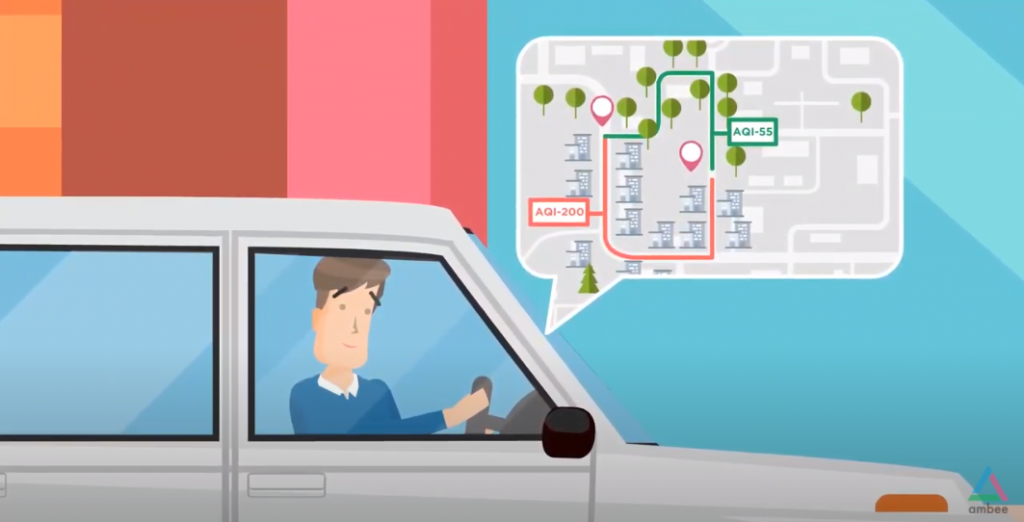Idea in Brief:
- Electric Vehicles (EVs) have become the next big solution for increasing efficiency in road transport and decreasing air pollution rates.
- Even though EVs are still at a nascent stage, they have begun to grab both manufacturers’ and customers’ attention with their claims of cost-saving, resource conservation, and low carbon footprints.
- Environmental data has the power to convert the already efficient electric cars into a much more sustainable and climate-friendly option for transportation. Find out more.
Over the last few years, the world’s population has grown exponentially crossing 7.9 billion in 2021. As the population growth increases, the rate of pollution and pressure exherted on earth and its resources also increase. Scientists & engineers are always attempting to improve the performance of conventional vehicles to use less fuel or emit fewer greenhouse gases into the atmosphere. The introduction of electric cars is an alternative on the horizon that is rapidly developing. Electric vehicles do not emit any emissions and require electricity power to operate, making them an environmentally responsible alternative to the ever-increasing demand for more automobiles and gasoline. It’s also a method to address the rising levels of greenhouse gases & other pollutants in the environment caused by conventional internal combustion engines (ICE). The global socioeconomic cost of air pollution caused by ICE is around $3 billion annually. Carbon emissions worsen air quality and contribute to rising global temperatures, which adversely impact climate.
The most significant advantage of electric vehicles is their contribution to enhancing air quality in cities. Pure electric vehicles create no greenhouse gas emissions when driving because they do not have a tailpipe. This significantly minimizes air pollution.
Number of Cars Sold Worldwide
In 2021, global car sales are predicted to reach slightly under 70 million units, up from 63.8 million in 2020. The sector has seen a decreasing trend as the global economy has slowed and the coronavirus epidemic has spread across all major economies. Before the pandemic, it was predicted that global car sales would exceed 80 million. In 2020, small car sales in the United States were 15% lower than in 2019, with a total market of 2.5 million vehicles less than in 2019, marking the first time after 2012 that the US industry was less than 15 million vehicles. Since the late 1990s, government policy in several countries has emphasized fuel efficiency to fulfill climate change targets. Using fewer fossil fuels results in lower CO2 emissions. Before they’re even burned, petroleum products increase environmental red flags. The process of extracting those from the earth is energy-intensive and can harm local ecosystems. Vehicles are America’s biggest polluters, accounting for roughly one-third of all air pollution. Carbon monoxide, smog, or other toxic emissions from vehicles are particularly concerning since they leave tailpipes at street level, where humans inhale the polluted air directly. The decrease in car sales is due to rising carbon emissions and air pollution.
Adoption Rate and Government Policies
In 2020, ten million electric automobiles will be on the road throughout the world. It was a watershed moment in the electrification of mass transportation. Electric vehicle sales accounted for 4.6% of total vehicle sales worldwide.
EVs are a new technology, so people take time to adopt new technology. Charging stations, maintenance, and batteries are all sources of concern. Electric vehicles (EVs) are less expensive, environmentally beneficial, and require little maintenance. However, EV adoption is hampered by range anxiety or the fear that the driver would run out of places to charge the vehicle. Cities & governments can help solve this problem by utilizing car data to design or assist in the construction of charging infrastructure. To begin with, automotive data parameters such as timestamp, location, state of charge (SOC), odometer, temperature, distance, model, and battery capacity allow for the analysis of driving patterns. These insights can be used to find and place the best charging station locations.
This continuing environmental data could be used to control usage over time, either by deciding which charging stations require backup and which can be turned off or by directing drivers to accessible charging stations via an app to boost mobility. This environmental data can be used at the infrastructure level to understand the impact of charging points on the power grid.
However, there is one factor that every electric car manufacturer should consider: the weather.
Several support policies of electric vehicles (EVs) were implemented in key markets over the last decade, resulting in significant growth of electric car models. Generous tax breaks aided the early adoption of light-duty electric vehicles (LDVs) and fueled the expansion of the EV manufacturing or battery industries. The policies, which included purchase subsidies and car purchase & registration tax rebates, were intended to close the price gap between electric vehicles & conventional automobiles. Such regulations were first applied in the 1990s in Norway, then in 2008 in the United States, and 2014 in China.
The role of electric vehicles in meeting fuel economy and CO2 emissions limits has grown as the rules have become more stringent. Currently, such requirements apply to roughly 85% of all car purchases worldwide. CO2 emissions limits in the European Union had a big influence in pushing electric car sales and reached 2.1 million in 2020, the highest yearly growth ever. Some governments use obligatory objectives for EV sales, such as California and China(3).
As the use of electric vehicles grows, public chargers that are both convenient and economical would become increasingly vital. Governments have responded by supporting EV charging infrastructure via initiatives such as direct funding to create publicly accessible chargers or subsidies for EV owners to build charging connections at home. Building codes in some areas, such as apartment buildings and retail enterprises, may necessitate new construction or major remodels charging outlets.
Impact of Weather Data on Sales
Driving in inclement weather, such as snow or heavy rain, can be difficult. Range anxiety, which occurs when drivers are concerned about where to charge these vehicles, is associated with inclement weather in electric vehicles.
In colder temperatures, all cars, whether gas-powered and electric, become less efficient. However, it has a greater impact on EVs: temperatures under 40° can considerably reduce battery range. The range of electric vehicles is reduced by up to 41% in cold weather. In cooler conditions, charging also takes longer. Different Apps will tell you about the weather and better navigation capabilities of an electric vehicle.
You may calculate your vehicle’s range using current or projected temperatures. The range can be used to evaluate how far a car can go along a route, establish better expectations for expected arrival times, identify charging stations nearby, or locate motels that are accessible based on the loss in battery life. According to research, warmer weather can also overheat batteries, which lose 4% of their efficiency without air conditioning but 17% with it. As a result, the issue of vehicle range becomes a little more problematic. If your vehicle’s technology doesn’t take weather into account when calculating range today, you risk leaving your drivers stranded – and possibly live Tweeting your vehicle’s failure.
How can Environmental Data Make the Car Much Smarter?
Driver journeys and routes can be indicated using environmental data properties and monitoring congestion and slowdowns. Cities may tune traffic signals in real-time by evaluating traffic congestion or slower-than-normal traffic in real-time. As a result, they can minimize driver stalling to a bare minimum. Drivers will be a lot happier on their journey to work and home as a result of this. It will also save money for the economy. Congestion results in wasted leisure activities hours, a decline in mental health, and a rise in air pollution. For both large and small economies, this amounts to millions of dollars per year.
A green-light guidance service for drivers could be developed as a more advanced option. Data may identify where the signals are green and traffic moves utilizing cameras like Mobileye (4). This new layer of automotive data may be integrated into navigation apps to help drivers find the most efficient routes. At best, hazardous roads are annoying; at worst, they can be deadly. Due to heavy use, concrete abrasion is prevalent, resulting in cracks, bumps, potholes, slippery places, and other issues. Road and sidewalk maintenance is so critical that officials need all the aid they can get.
Safe Navigation Route using Weather, Air Quality, and Pollen Data

The weather has a big impact on navigation procedures. Driving in heavy rain, for instance, is slower and riskier due to reduced vision than driving under ideal weather circumstances. As a result, adding weather information is important from the standpoint of time management and safety. Because some goods, such as straw or sand, should not be wet, the weather, particularly rain, may be crucial for transportation duties. The accuracy of weather data and forecasts has increased in recent years, and they may now be used to enhance route planning.
Customers’ concerns about air pollution have prompted automakers to respond quickly, with Tesla and Ford adding superior filtration systems inside their latest models. On the other hand, it can warn drivers when they’re driving through a contaminated area. Integrating the vehicle’s automation system can intervene as early as possible to start raising the windows, close the sunroof, & turn on the A/C, ensuring that only clean air is used in the cabin before the circulation system is used turned on, safeguarding drivers from pollutants outside.
Automatic Working of Air Filter Based on External Air Quality Levels
Cabin air filters were designed to filter out relatively large particles such as pollen and dust, but they are ineffective at filtering out much smaller, sub-micrometer particulates found in car emissions. Carbon dioxide, which passengers would exhale, and nitrogen oxide, that enters the cabin through vehicle emissions aren’t normally filtered and therefore can impair decision-making, make people tired, or have negative health impacts. Heavy and stop-and-go traffic, vehicle speed, ventilation fan speed, pollutants in the outside air, as well as the number of people in the car can all affect cabin air quality.
Conclusion
Weather can affect how effectively your electric vehicle works, according to the US Department of Energy. It has an impact on the EV’s mobility and might make it unpredictable. According to a study, extreme weather has a substantial impact on driving mobility. The driving range is reduced by 17% when the temperature is 95° F and the air conditioning is turned on (a requirement for the most in 95° heat). Environmental data aids in the improved operation of electric vehicles. It’s a good idea to plan your trip. It helps in improving the efficiency of electric vehicles during unpredictable weather.
About Ambee
Ambee is an environmental intelligence startup that measures, processes, and analyzes hyperlocal air quality data in real-time. Using AI and IoT, Ambee provides location-specific, real-time air quality data and actionable insights to businesses and consumers to mitigate the effects of air pollution. Ambee uses a multimodal approach to monitor air quality at a street-by-street level. In addition to government sensor data, proprietary IoT sensors, and open-source data, Ambee uses satellite imagery, weather, and meteorological data, to measure air quality. Ambee’s proprietary algorithms carefully factor in human activities like garbage burning, vehicular traffic, construction and industrial emissions that play a major role in pollution and GHG emissions, and other hyperlocal environmental factors.
Explore and Learn More About Ambee’s Air Quality API

I have a deep-seated passion for the environment and in helping people improve the way they live their lives. As a co-founder at Ambee, I am committed to empowering individuals and businesses alike with the environmental data they need to heal our planet’s health.

I have a deep-seated passion for the environment and in helping people improve the way they live their lives. As a co-founder at Ambee, I am committed to empowering individuals and businesses alike with the environmental data they need to heal our planet’s health.




